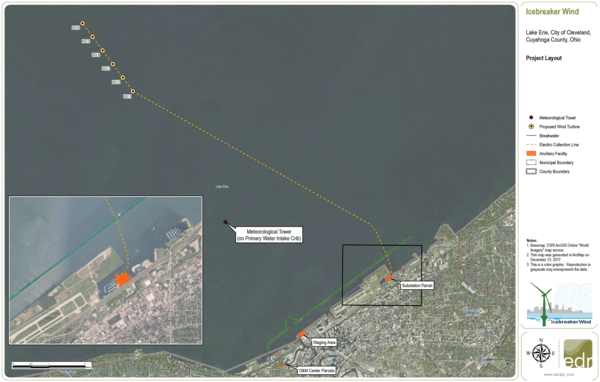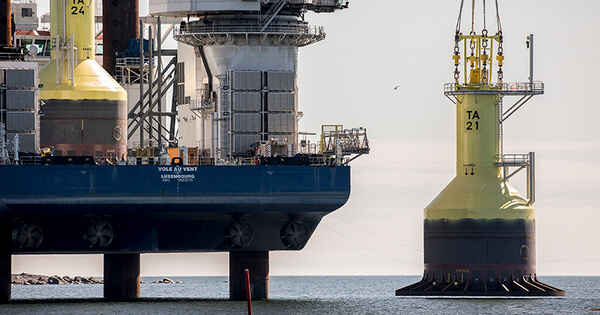News Release from windfair.net
Wind Industry Profile of
Icebreaker Project - A New Challenge
In many places along the European coasts, offshore wind farms produce electricity on the scale of large power plants. Research is now also being carried out on floating turbines for deeply sloping coastal strips to make more marine regions usable for electricity production.
In the U.S. there is a project that could bring even more areas into the focus of project developers: Sweet water. For several years, developer Lake Erie Energy Development Corp. (LEEDCo) has tried to set up a demonstration project consisting of six wind turbines in Lake Erie.
Lake Erie is the fourth largest of the Great Lakes on the U.S./Canadian border. The states of Michigan, Ohio, Pennsylvania and New York, with cities like Cleveland and Buffalo are bordering the lakes. The connection of the offshore turbines to the existing power grid is therefore the least of the problems due to short distances. If the relevant commissions finally give the go-ahead for the project by autumn this year at the latest, this could lead to a novelty in the United States: Offshore wind turbines in a freshwater lake.
Now offshore wind power is still rare in the U.S. with only one small offshore wind farm so far. Many Americans are still sceptical about this type of energy generation, especially since experts see no real need to set up offshore turbiens in the country's interior at all. The simple argument: There is enough land. And indeed, the Midwest offers a lot of space with good wind conditions. Nevertheless, there is great interest in the pilot project.

The six turbines are to be installed off the coast of Cleveland. (Image: LEEDCo)
In the first place, there is not much difference whether the turbines are installed in salt water or fresh water - apart from the signs of wear caused by aggressive salt. In this particular case, however, another phenomenon is added due to the location of the planned project: In winter there is heavy ice formation in the narrow, relatively shallow Lake Erie called 'ice shove' by the locals. Ice floes form pack ice with heights of over 10 - 15 metres due to strong wind and various water currents near the shore.
Ice can also form on the sea surface in the Baltic Sea in winter. However, the American journal Scientific American points out that there are differences between the formation of ice in saline and fresh water: Frozen salt water tends to hang deeper below the waterline than frozen fresh water which is more floating on the surface - a phenomenon also known from icebergs. So how can wind turbines be protected from the immense forces emanating from these uncontrollable ice masses?
It is not for nothing that the American project in Lake Erie is named 'Icebreaker'. For this purpose, inverted cones are to be attached to the towers of the plants at water level. The idea is that the cones deflect the ice moving towards the turbine and push it down past the tower. For this reason mono buckets forming relatively few windage are planned as foundations.

The first offshore wind farm specially designed for hard winters with ice formation in Finland (Photo: Hyötituuli)
A similar test system was already installed last year in Finland in the Baltic Sea, but has not yet been able to demonstrate its capabilities due to the mild winter. Whether the cones are really sufficient to protect the facilities from the ice floes for four long winter months in the year has to be proven for the first time in Lake Erie.
So far, the Americans have benefited of European offshore wind know-how. So it would be a novelty if it were the other way around in this case.
- Author:
- Katrin Radtke
- Email:
- press@windfair.net
- Keywords:
- Icebreaker, USA, offshore, Lake Erie, fresh water, LEEDCo, developer, location, salt water, foundation, mono bucket

























